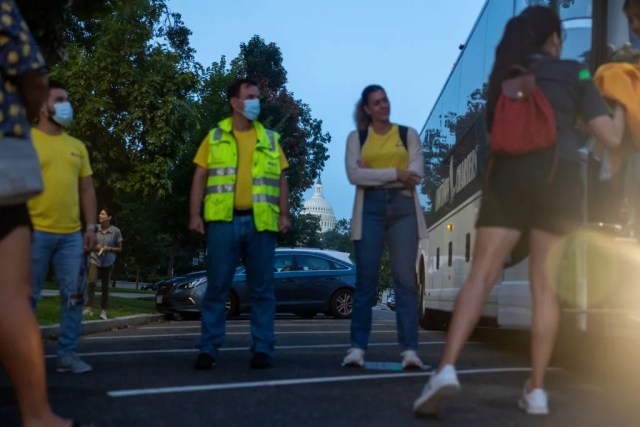
Thousands of migrants are being bused to U.S. cities in the hope of building new lives. Reality is often different.
By The Center for Public Integrity – Ileana Garnand
June 2, 2023
Reading Time: 5 minutes
Maryuri embarked on her three-month journey from Venezuela to the U.S. in July 2022, crossing nine borders on crutches with a broken foot.
She traveled with her son, now 9 years old. Their path included traversing the often deadly Darién Gap between Colombia and Panama.
She fled an economic crisis that left her unable to afford basic necessities like food and antibiotics, under the shadow of the Venezuelan government’s human rights abuses. Public Integrity is not publishing Maryuri’s full name to protect the safety of her and her family.
Soon after arriving in Texas in October, Maryuri and her son boarded a bus bound for D.C. where she hoped “to prosper, not just survive.”
Instead, Maryuri said she has struggled to access quality food, stable and clean housing, work opportunities and affordable health care because of her migrant status.
Maryuri and her son are among at least 9,400 Latin American migrants who have been voluntarily bused to D.C. from Texas and Arizona in the past year. The approximately 12% who stay in the city face similar challenges as Maryuri, according to advocacy groups, which are pushing for more long-term solutions.
“We are being penalized for being poor and this goes against the definition of sanctuary that this city supposedly claims to be,” Maryuri told the D.C. Council on Feb. 23.
Temporary solutions, long-term needs
The Migrant Services and Supports Act passed late last year authorized D.C.’s mayor to establish programs for the arriving migrants, including the Office of Migrant Services. The new division supports bus reception, immediate care of new arrivals, temporary housing and, if desired, transportation to other destinations.
The city should “absolutely” have an office and accompanying legislation that provides services to migrants, said Eli Johnson, executive director of Congregation Action Network, which has been working with the migrants since the first buses arrived. However, the current system “is very focused on short-term emergency services and not long-term resettlement services,” Johnson said.
The act bars those eligible for aid through the Office of Migrant Services from resources provided to unhoused people in the district under homeless services law. This includes long-term housing and childcare vouchers.
“There should be no immigration-based restrictions on any services in the city,” Johnson said.
An emergency amendment to the migrant services law was enacted in late April to clarify who is eligible for aid, require written denials and set shelter safety standards. But these policies are set to expire later this summer. A proposed extension is awaiting congressional review.
“We are still evaluating what a permanent support system for migrants coming to D.C. should look like,” said Councilmember Robert White, who introduced the legislation.
“Dirty and dangerous” housing
After arriving last fall, Maryuri and her son moved into one of the three shelters the city set up for migrants with children. These facilities reached capacity on April 26, with about 1,250 people across 370 families, according to city officials.
The city is keeping the shelters closed despite having open rooms, said Madhvi Venkatraman, a core organizer with Migrant Solidarity Mutual Aid Network, which was formed in response to the buses. MSMAN reported the facilities now house 359 families.
Venkatraman estimated that there are about 20 migrant families in Washington currently without housing.
“There are definitely a bunch of families sleeping in cars or some that are out in the streets that we don’t know of because not everybody knows [about MSMAN],” she said.
Those who are staying in the family shelters have experienced “dirty and dangerous” conditions like bed bugs and mold, Maryuri said.
The food is sometimes raw or rotten, she said. Maryuri and her son have experienced stomach aches, diarrhea and hair loss.
“I live without appetite and without energy due to the malnutrition that we are experiencing in the [shelter] due to the poor quality of the food we receive,” Maryuri told the council in February.
But council members, including White, who visited the shelters in March saw a different picture. He said the rooms he was shown were clean and OMS staff “made it sound like they had responded to issues with food” and other necessities.
“But the fact that what I saw on my visit contrasts so strongly with what I’ve heard directly from migrants and advocates makes me believe the emergency legislation is even more important to ensure our agencies are clear on the services and resources they are required to provide,” White said.
Shelter residents told Johnson that the visiting council members were taken to a room that had been cleaned in anticipation of the visit. It was made to look “much better than what the migrants are actually living in,” Johnson said.
Migrants without families rely on short stays at homeless shelters and volunteers’ houses, Venkatraman said. For long-term options, advocacy groups try to find cheap apartments. Venkatraman said MSMAN sometimes pays the first month’s rent, furnishes apartments and even co-signs leases. But that’s not sustainable in a city with housing costs 50% higher than the national average.
“We can’t put up people indefinitely in housing, we don’t have the resources,” Venkatraman said.
…
Read More: The Center for Public Integrity – As migrant busing continues, advocates push for long-term solutions
…

